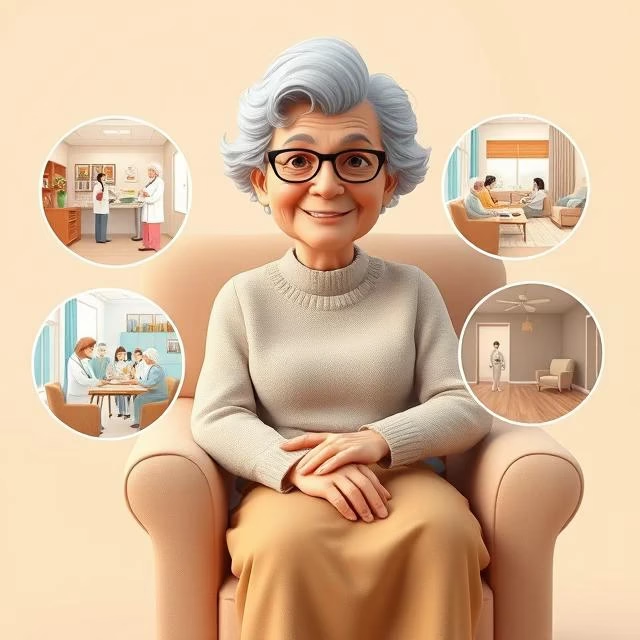In-home care has become an essential part of the healthcare landscape, but what exactly makes it so critical in today’s society? As the world population ages and healthcare costs continue to escalate, the demand for personalized and convenient care solutions has risen. But is in-home care truly the answer to these challenges, and how does it work in practice?
Understanding the Basics of In-Home Care

In-home care, often referred to as domiciliary care, encompasses a variety of services that provide support and medical assistance to individuals in the comfort of their own homes. It caters primarily to seniors, disabled persons, and those recovering from surgery or illness who need help with daily activities or medical needs. The core concept is simple: deliver personalized care without the need for hospital or nursing home settings.
| Aspect | Description | Examples |
|---|---|---|
| Personal Care | Assistance with daily living activities | Bathing, dressing, grooming |
| Medical Care | Nursing and therapeutic services | Medication management, wound care |
| Companionship | Social interaction and mental stimulation | Conversation, activities, outings |
| Household Support | Help with household tasks | Cleaning, cooking, shopping |
In-home care is designed to promote the well-being and independence of individuals while allowing them to remain in familiar surroundings.
The Benefits of Domiciliary Care
The advantages of domiciliary care are manifold. Firstly, it provides a personalized approach to healthcare, as services are tailored to the individual’s specific needs and preferences. This level of customization is often not achievable within institutional settings. Additionally, being in a familiar environment can have psychological benefits, fostering a sense of comfort and security which may aid in quicker recovery and improved overall well-being.
Moreover, it offers flexibility and can be adjusted as the needs of the individual change. Services can range from a few hours a week to 24/7 care, depending on what is necessary for the client’s health and lifestyle.
Another significant benefit is the opportunity for family involvement. Family members can have greater participation in their loved ones’ care journeys, providing emotional support and oversight that enhances care quality.
“Home is a place you grow up wanting to leave, and grow old wanting to get back to.” – John Ed Pearce
Comparing In-Home Care to Other Care Options

When considering care options, it’s crucial to understand the alternatives. Nursing homes, assisted living facilities, and hospitals each have their roles, but they differ significantly from in-home care.
Nursing homes provide round-the-clock medical care, often for individuals with chronic conditions that require intensive monitoring. Assisted living facilities offer a middle ground for those who are relatively independent but need some assistance with daily activities. Hospitals are typically for acute care needs and not designed for long-term habitation.
1- Cost Considerations: In-home care can be more cost-effective compared to the high expenses associated with nursing homes and extended hospital stays.
2- Quality of Life: Individuals often report higher levels of satisfaction and quality of life when receiving care at home.
3- Independence: In-home care supports autonomy and independent living for as long as possible.
4- Personalization: The ability to tailor services closely to personal needs differentiates in-home care significantly from other options.
Roles and Responsibilities in Domiciliary Care
Domiciliary care involves various roles from healthcare professionals, caregivers, to family members. Understanding these roles is crucial to maximizing the care provided.
Professional caregivers, often certified nursing assistants or home health aides, provide day-to-day personal care and assistance with activities of daily living. Nurses and therapists might be involved in more complex medical care such as wound management, physical therapy, or administration of medication. Care coordinators ensure that all services are aligned and any changes in the care plan are managed smoothly.
Family members often play a supportive role, coordinating logistics, managing finances, and providing emotional backing. Their involvement is pivotal in ensuring the care provided aligns with the personal values and preferences of the individual receiving care.
Challenges and Limitations
Despite its benefits, in-home care is not without challenges. One major issue can be the availability of skilled caregivers, especially in rural areas. Recruiting, training, and retaining qualified staff to provide high-quality care can be a tremendous hurdle. Additionally, ensuring safety and accessibility at home can require significant modifications, which might add to the overall cost.
Limitations in supervision and immediate access to medical professionals can also be a concern. This factor makes in-home care less suitable for individuals with severe health conditions requiring continuous medical monitoring.
Technological Advancements In-Home Care

Technology is increasingly playing a vital role in enhancing the efficacy of in-home care. Telehealth services allow remote monitoring and consultations, reducing the need for frequent hospital visits. Wearable devices offer real-time health tracking, alerting caregivers and medical professionals to any potential issues promptly.
Furthermore, smart home technology can increase safety and ease of living. For instance, automatic lighting, fall detection, and voice-activated devices can provide additional layers of support and security to those opting for in-home care.
Financial Aspects
Navigating the financial dynamics of in-home care can be complex but is a crucial aspect to consider. Understanding payment options, insurance coverages, and potential financial assistance are key to ensuring that care is affordable and sustainable.
While Medicare and Medicaid may cover some costs associated with domiciliary care, eligibility criteria and coverage vary by state and individual circumstances. Long-term care insurance can also be an option, but it needs to be set up well before care is required.
It is imperative to explore all available resources such as veterans’ benefits, local government programs, and non-profit organizations that may offer support or funding to offset costs.
FAQ – Common Doubts
What types of services does in-home care typically include?
In-home care includes a broad range of services such as personal care, medical assistance, companionship, and household support.
Is in-home care suitable for everyone?
Not necessarily. It is generally best for those who require support but not intensive medical supervision. It’s important to assess individual needs and consult healthcare professionals.
How can I ensure the quality of in-home care services?
Researching and choosing reputable providers, checking qualifications, and maintaining open communication with caregivers are essential steps to ensure quality care.
How does in-home care compare financially to other options?
It can be more cost-effective than nursing homes or extended hospital stays, but this depends on the level of care required and regional cost variations.
Can technology significantly enhance in-home care experience?
Yes, with advancements like telehealth, wearable devices, and smart home technologies, the safety and efficiency of in-home care can be greatly improved.
Conclusion
In-home care has emerged as a vital component in the larger spectrum of healthcare services. It offers a compassionate and personalized alternative to institutional care, emphasizing independence, familiarity, and dignity for individuals in need. While it presents certain challenges, such as caregiver availability and initial setup costs, its benefits in providing a tailored care experience are undeniable. As technological advancements continue to evolve, the future of in-home care looks promising, ensuring that individuals can age gracefully while enjoying the comforts of their own homes.





